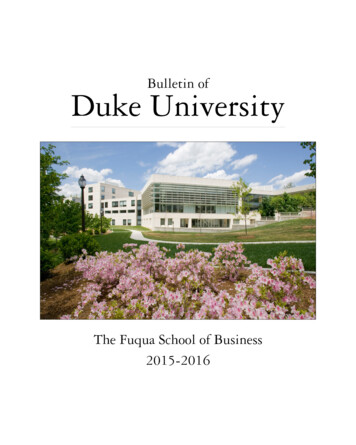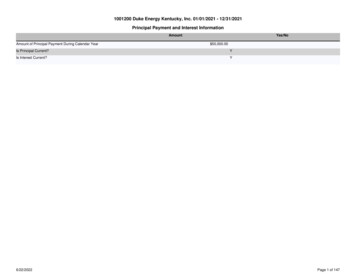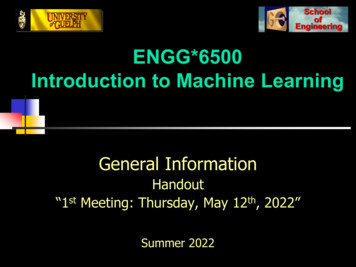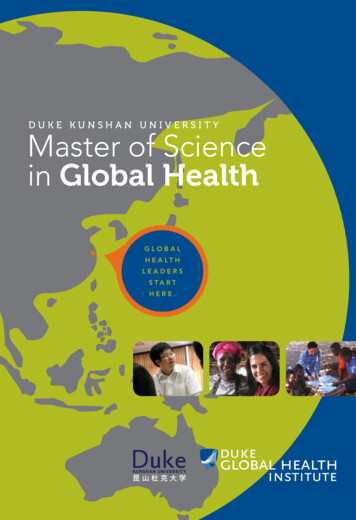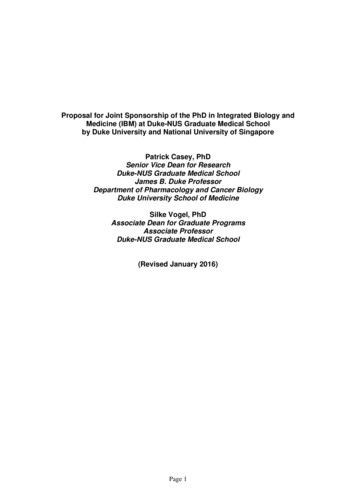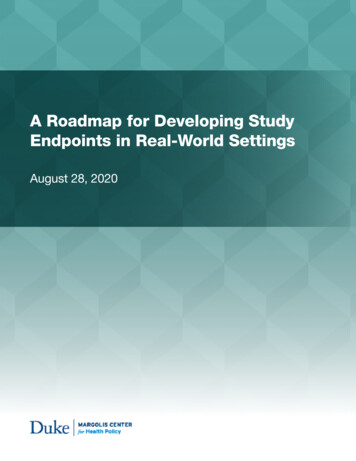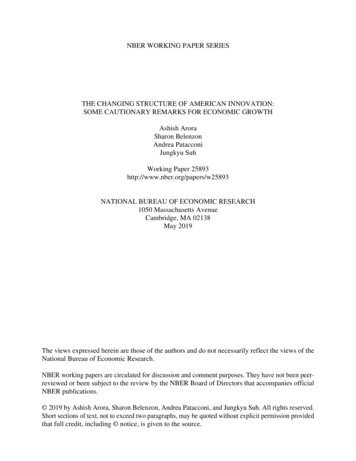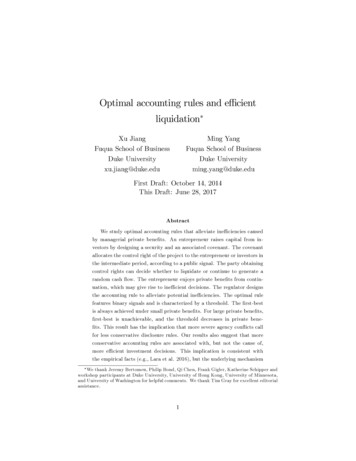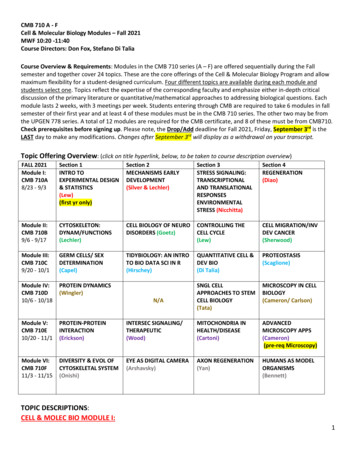
Transcription
CMB 710 A - FCell & Molecular Biology Modules – Fall 2021MWF 10:20 -11:40Course Directors: Don Fox, Stefano Di TaliaCourse Overview & Requirements: Modules in the CMB 710 series (A – F) are offered sequentially during the Fallsemester and together cover 24 topics. These are the core offerings of the Cell & Molecular Biology Program and allowmaximum flexibility for a student-designed curriculum. Four different topics are available during each module andstudents select one. Topics reflect the expertise of the corresponding faculty and emphasize either in-depth criticaldiscussion of the primary literature or quantitative/mathematical approaches to addressing biological questions. Eachmodule lasts 2 weeks, with 3 meetings per week. Students entering through CMB are required to take 6 modules in fallsemester of their first year and at least 4 of these modules must be in the CMB 710 series. The other two may be fromthe UPGEN 778 series. A total of 12 modules are required for the CMB certificate, and 8 of these must be from CMB710.Check prerequisites before signing up. Please note, the Drop/Add deadline for Fall 2021, Friday, September 3rd is theLAST day to make any modifications. Changes after September 3rd will display as a withdrawal on your transcript.Topic Offering Overview: (click on title hyperlink, below, to be taken to course description overview)FALL 2021Module I:CMB 710A8/23 - 9/3Section 1INTRO TOEXPERIMENTAL DESIGN& STATISTICS(Lew)(first yr only)Section 2MECHANISMS EARLYDEVELOPMENT(Silver & Lechler)Section 3STRESS SIGNALING:TRANSCRIPTIONALAND TRANSLATIONALRESPONSESENVIRONMENTALSTRESS (Nicchitta)Section 4REGENERATION(Diao)Module II:CMB 710B9/6 - 9/17CYTOSKELETON:DYNAM/FUNCTIONS(Lechler)CELL BIOLOGY OF NEURODISORDERS (Goetz)CONTROLLING THECELL CYCLE(Lew)CELL MIGRATION/INVDEV CANCER(Sherwood)Module III:CMB 710C9/20 - 10/1GERM CELLS/ SEXDETERMINATION(Capel)TIDYBIOLOGY: AN INTROTO BIO DATA SCI IN R(Hirschey)QUANTITATIVE CELL &DEV BIO(Di Talia)PROTEOSTASIS(Scaglione)Module IV:CMB 710D10/6 - 10/18PROTEIN DYNAMICS(Wingler)SNGL CELLAPPROACHES TO STEMCELL BIOLOGY(Tata)MICROSCOPY IN CELLBIOLOGY(Cameron/ Carlson)Module V:CMB 710E10/20 - 11/1PROTEIN-PROTEININTERACTION(Erickson)INTERSEC SIGNALING/THERAPEUTIC(Wood)MITOCHONDRIA INHEALTH/DISEASE(Cartoni)ADVANCEDMICROSCOPY APPS(Cameron)(pre-req Microscopy)Module VI:CMB 710F11/3 - 11/15DIVERSITY & EVOL OFCYTOSKELETAL SYSTEM(Onishi)EYE AS DIGITAL CAMERA(Arshavsky)AXON REGENERATION(Yan)HUMANS AS MODELORGANISMS(Bennett)N/ATOPIC DESCRIPTIONS:CELL & MOLEC BIO MODULE I:1
CMB 710A-01 / INTRODUCTION TO EXPERIMENTAL DESIGN AND STATISTICSInstructor: Lew, Daniel JSummary: What is a good experiment and what isn’t? What controls should be present in the experiment, and why?How can we avoid being misled? How much data do we need to persuade someone of our conclusions? This class willuse problem sets and group learning to address these questions. No prior readings required.Prerequisite: First year students onlyCMB 710A-02 / MECHANISMS OF EARLY DEVELOPMENTInstructor: Silver, Debra & Lechler, TerrySummary: This module will cover the maternal to zygotic transition, initial asymmetries that launch cellular diversity,onset of signaling, mechanisms of specification, and control mechanisms necessary for morphogenesis. It will emphasizethe means by which genomic information is used to drive development. Each class period will be a combination ofprimary literature review, lecture and discussion. Animal examples will be drawn from across the animal kingdom.Reading:1) Molecular Biology of the Cell, Alberts, et al., 6th edition - Chapter 212) Developmental Biology, Gilbert, 10th edition - Chapters 1-3CMB 710A-03 / STRESS SIGNALING: TRANSCRIPTIONAL AND TRANSLATIONAL RESPONSES TOENVIRONMENTAL STRESSInstructor: Nicchitta, ChristopherSummary: In this module we will trace the path of research leading to the discovery of the unfolded protein response(UPR), a critical signaling pathway ubiquitously expressed in all eukaryotes. The UPR couples translational andtranscriptional regulatory pathways to environmental stressors, such as glucose and/or amino acid deprivation oroxidative stress, and provides a common mechanism for sensing and adapting to cell stress. In this module, we will read,discuss, and critique the primary literature reporting the discovery of the UPR, the molecular components that compriseit, and its mechanism and regulation.A basic knowledge and understanding of the secretory pathway and the protein synthesis and processing functions ofthe endoplasmic reticulum (ER) is necessary for this module.Reading: The Endoplasmic Reticulum, Molecular Biology of the Cell, 4th edition, Alberts et al. Available free of chargefrom the NCBI: https://www.ncbi.nlm.nih.gov/books/NBK26841/CMB 710A-04 / REGENERATIONInstructor: Diao, YaruiSummary: Regeneration means the regrowth of a damaged or missing organ part from the remaining tissue. Humanscan regenerate some organs, including the skin, liver, bone, and skeletal muscle. However, many other human tissues,such as heart and brain, only have very limited regeneration capacity. Questions of how and why tissue regenerationoccurs or not in health and pathology have captured the attention of countless biologists, biomedical engineers, andclinicians. In this module, we will focus on skeletal muscle as the model system, to cover key concepts and mechanismsof tissue regeneration. We will also discuss the different regenerative strategies and mechanisms that are used by avariety of model organisms, including salamanders, planarians, and zebrafish, to understand regeneration.Reading:2
1) Brack, A. and Rando, T. (2012). Tissue-specific stem cells: lessons from the skeletal muscle satellite cell. Cell Stem Cell10, 504-514.2) Poss, K. D. (2010). Advances in understanding tissue regenerative capacity and mechanisms in animals. NatureReviews Genetics 11, 710-722.3) Wosczyna, M. and Rando, T. (2018) A Muscle Stem Cell Support Group: Coordinated CellularResponses in Muscle Regeneration. Dev Cell. 46(2):135-143CELL & MOLEC BIO MODULE IICMB 710B-01 / THE CYTOSKELETON: DYNAMICS & FUNCTIONSInstructor: Lechler, TerrySummary: This is a primary literature reading intensive course that will cover aspects of cytoskeletal dynamics andfunctions in reconstituted systems, cultured cells and intact organisms. Diverse topics will be discussed, which mayinclude: the role of cytoskeleton in mitosis/cytokinesis, cell migration, cell adhesion, cell signaling, cell shape control andmechanotransduction. Preparation and active participation required.Reading: Molecular Biology of the Cell, Alberts et al. Chapter 16 (Cytoskeleton)CMB 710A-02 / THE CELL BIOLOGY OF NEURODEVELOPMENTAL DISORDERSInstructor: Goetz, SarahSummary: This module will cover the cell biology of pediatric brain and neurodevelopmental disorders. Topics ofdiscussion will include the basis of neural tube closure defects, the role of mitosis/cell divisions, centrioles, and ciliarysignaling in neurological development. We will also discuss new findings relating neurological disorders to defects inmetabolism, infectious diseases, somatic mutations, and other emerging areas. This module will be literature based,with students presenting and discussing new and classic primary papers.Reading: N/ACMB 710B-03 / CONTROLLING THE CELL CYCLEInstructor: Lew, Daniel JSummary: The accurate copying of a cell's contents and their distribution to produce two daughter cells is a stunningfeat requiring exquisite coordination. The set of carefully orchestrated steps by which proliferating cells make copies ofthemselves constitutes the cell cycle. In this module, we will discuss landmark papers that established the conservedmechanisms underlying cell cycle control, as well as recent papers dissecting the control circuitry.In addition to learning about a fundamental process, we will explicitly deal with strategies for reading primary Journalarticles to critically assess the validity of their conclusions. We will also discuss how to turn cartoon diagrams ofregulatory pathways into equations and graphs producing quantitative predictions of pathway behavior, and address theimportance of feedback pathways and bistable systems in generating sharp transitions in cell behavior.Reading:"The Molecular Biology of the Cell", Alberts et al. Chapter 17: The Cell Cycle. (including the Mechanics of Cell Division).CMB 710B-04 / CELL MIGRATION/INVASION IN DEVELOPMENT & CANCERInstructor: Sherwood, David R3
Summary: Cell migration/invasion through extracellular matrix and tissues play crucial roles in the development,maintenance and regeneration of multicellular organisms. Inappropriate and defective cell migration also underliesnumerous diseases, including inflammatory diseases (i.e. asthma, rheumatoid arthritis, multiple sclerosis, psoriasis andCrohnʹs disease), developmental disorders, and tumor spread. Understanding cell migration is also important forregenerative therapies, including stem-cell grafting, where defective migration/invasion is a major limitation. Cellmigration takes on a variety of forms, and this course covers how cells migrate and invade as individuals, in groups aswell as the plasticity of migration modes in development and cancer.Reading:Plasticity of cell migration: a multiscale tuning model. Friedl P1, Wolf K. J., Cell Biol. 2010 Jan 11;188(1):11-9. doi:10.1083/jcb.200909003. Epub 2009 Dec 1.CELL & MOLEC BIO MODULE IIICMB 710C-01 / GERM CELLS / SEX DETERMINATIONInstructor: Capel, BlancheSummary: This module will cover the formation, pluripotent characteristics, and male vs. female development ofprimordial germ cells in multiple species including Drosophila, C. elegans, fish and mammals. It will also cover sexdetermination and cell fate commitment in somatic cells of the gonad, including genetic and temperature/hormonedependent mechanisms. We will likely also cnsider how sex chromosomes evolve and how species transition betweensex determining mechanisms.Reading:Developmental Biology, Gilbert:Chapter 15 - Sex DeterminationChapter 17 - The Saga of the Germ LineCMB 710C-02 / TIDYBIOLOGY: AN INTRODUCTION TO BIOLOGICAL DATA SCIENCE IN RInstructor: Hirschey, MatthewSummary: This workshop-style module provides an introduction to the emerging field of Data Science in R, includingdata analysis and visualization, with a particular focus on its utility for biological insight.Students will be provided with biological datasets, and introduced to R packages and code used to examine data. In thefirst half of each class, students will be lectured on methods and shown demonstrations; in the second half of each class,studies will use tools to analyze real data; laptop computers are required. Methods for filtering, sorting, andtransforming data will be discussed along with visualization tools and options. Particular attention will be paid to codeinterpretation and data provenance methods by learning to generate reproducible data output files. For a final project,students will be given a new dataset to analyze using the tools learned during the course, and will share findings withthe class in a short oral presentation. Although specific datasets will be used for analysis in class, this workshop willprovide broadly applicable tools to reproducibly analyze and visualize data across the biological sciences.4
CMB 710C-03 / QUANTITATIVE CELL & DEVELOPMENTAL BIOLOGYInstructor: Di Talia, StefanoSummary: It is a common belief that biology is the least quantitative and theoretical of the natural sciences. However,many fundamental discoveries in biology (e.g. membrane excitability, spikes, proofreading) have come from the use ofmodeling and theoretical ideas. The goal of this module is to show how theoretical and mathematical ideas can contributeto develop deeper insights on biological problems. Focusing on primary literature, we will discuss how recentadvancements in imaging technologies are improving our understanding of cell and developmental biology. Ideally by theend of this module, students will be able to distinguish good informative mathematical models from less informativemodels.Reading:1) Nurse, P and Hayles, J (2011) The Cell in an Era of Systems Biology. Cell, 144 (6), 850-854 2) Oates, AC,Gorfinkiel, N, Gonzalez-Gaitan, M, Heisenberg, CP (2009) Quantitative approaches in developmental Biology.Nature Reviews Genetics, 10, 517-530.CMB 710C-04 / PROTEOSTASISInstructor: Scaglione, K MatthewSummary: Maintenance of protein homeostasis (proteostasis) is essential for cellular health. In a number of diseasesproteostatic pathways are altered and contribute to disease pathogenesis. This ranges from an increase in proteostaticcapacity in cancer to a dysregulation of protein folding in most neurodegenerative diseases. In this module we will readand discuss key papers that cover the regulation of proteostasis in health and disease.Reading: N/ACELL & MOLEC BIO MODULE IVCMB 710D-01 / PROTEIN DYNAMICSInstructor: Wingler, Laura MSummary: Proteins are not static molecules, and their structural flexibility is one of the fundamental reasons that theyare able to exhibit such functional versatility. Using case studies from the literature, this module will explore broadthemes in: (1) how proteins inherently explore multiple conformations (shapes); (2) how the conformations of proteinscan be regulated by the cellular environment, extracellular signals, and drugs; and (3) how this regulation modulates andbroadens the biological functions of proteins.ReadingN/ACMB 710D-2 / N/ACMB 710D-03 / SINGLE CELL APPROACHES TO STEM CELL BIOLOGYInstructor: Tata, Purushothama RaoSummary: Most tissues rely on specialized cells called stem/progenitor cells for their day-to-day turn over. Stem cells insome tissues directly differentiate into mature cells whereas in some cases they undergo replication and generateintermediate cells which then differentiate into mature cell types. Both systemic and micro-environmental factorsdynamically control the behavior of stem cells in a context dependent manner. In this module we will be discussing howdifferent factors such as microenvironment, cell-cell communication and cell plasticity influence stem cell behavior to5
control tissue homeostasis, regeneration and tumorigenesis. We will also discuss some of the new tools developed tounravel emerging concepts that are put forward in the recent years in stem cell biology. Categories:1. Stem cells, development & regeneration 2.Physiology & diseaseReading:1. Developmental Biology by Scott F. Gilbert; 9th or 10th or 11th edition; Chapters- 2, 4 and 5.2. Human Cell Atlas- White Paper, eLife, 2017CMB 710D-04 / MICROSCOPY IN CELL BIOLOGYInstructor: Cameron, Lisa and Carlson, BenjaminSummary: Microscopy has been revolutionized by fluorescence and now provides a vast array of tools with which toinvestigate biology. This module will cover the principles and techniques of light microscopy – how microscopes andphoton-based imaging systems work and what you can do with them. We will discuss a range of techniques emphasizingthe most common applications encountered in biological research - widefield imaging, optical sectioning by confocals,multi-photon excitation and TIRF microscopy. The theory and physical principles of the imaging systems will beexplained in the first half of the module in a lecture based setting to a level giving understanding of how they work andguidance for optimal use. The second part of the module will be a mixture of theory and exercises in FIJI/ImageJcovering the processing, visualization and quantification of microscopy data. This is the prerequisite to the AdvancedMicroscopy Applications module.Reading:Molecular Biology of the Cell, Alberts, et al., - Chapter 9 (focus on the sections discussing light/fluorescence microscopy)CELL & MOLEC BIO MODULE VCMB 710E-01 / PROTEIN-PROTEIN INTERACTIONInstructor: Erickson, Harold PSummary: Proteins are the machines of the cells. A few enzymes operate alone, but most proteins interact with othersto form more complex machines. In this unit we will learn the basic principles of protein-protein interaction andbonding and address the following questions.How big is a protein molecule; how do you determine if it is a monomer or tetramer; how do you determine its shape?What is the structure of a protein-protein bond? How many amino acids are in contact? How does the dissociationconstant relate to the strength of the bond? How fast do two proteins form a bond, and once formed how long does thecomplex last before it dissociates? If you want to eliminate or reduce a protein-protein bond by mutagenesis, how manyamino acids to you need to change? How do you decide which ones?Reading:Molecular Biology of the Cell", Alberts et al., Chapter 3 - Proteins.Chapter 2 (to review basic biochemistry. Most important is to know the amino acids, which ones are hydrophobic,hydrophilic, charged)6
CMB 710E-02 / INTERSECTION OF SIGNALING & THERAPEUTICSInstructor: Wood, Kris CSummary: It is now possible to comprehensively map the numerous genomic alterations present in individual humantumors. As a result of this stunning technological advance, we can now begin to design therapeutic strategies thatfunction by “targeting” these alterations. However, identifying the optimal therapeutic targets for a given tumor ischallenging, and this challenge is further exacerbated by the problem of drug resistance, which commonly emerges astumors evolve under pharmacological selection pressures. In this module, we will construct a framework forunderstanding the related topics of pharmacogenomics and drug resistance in cancer, discussing landmark papers thatestablished the guiding principles in each field.Reading:1) McLeod, Cancer pharmacogenomics: Early promise, but concerted effort needed. Science 339, 1563 (2013).2) Glickman and Sawyers, Converting cancer therapies into cures: Lessons from infectious diseases. Cell 148, 1089 (2012).CMB 710E-03 / MITOCHONDRIA IN HEALTH AND DISEASESInstructor: Cartoni, RomainSummary: Mitochondria are responsible for key cellular functions such as energy production, reactive oxygen speciesregulation and calcium buffering. Moreover, it is an extremely dynamic organelle that is able to divide, fuse and movealong microtubule track. The importance of mitochondrial functions and dynamics is evidenced by the numerousdiseases such as cancer, diabetes and neurodegenerative diseases that have been linked to mitochondrial dysfunction.Therefore it is more important than ever to better understand the physiology of this multifaceted organelle. Through aseries a classic, provocative and recent papers, this course will provide an overview of mitochondrial biology and its rolein pathophysiological conditions with a special emphasis on mitochondrial dynamics and neurodegeneration.Reading:1. J. Clin. Invest. 2019 Area-Gomez2. Cold Spring Harb Perspect Biol 2013 Schwarz3. Annu. Rev. Genet. 2012 ChanCMB 710E-04 / ADVANCED MICROSCOPY APPLICATIONSInstructor: Cameron, LisaSummary: Over the last ten years, advancements in hardware and development of various probes have fueled higherresolution imaging techniques dubbed “super-resolution” along with other related methods. This module will build onthe information from the “Microscopy in Cell Biology” module to cover specifics of ways to resolve beyond thediffraction limit and collect images in 3D with greater speed than typical optical sectioning. The format will be mostlylecture style with some opportunity for demonstration or tour – this will be discussed in class. We will discuss how thesetechniques may benefit your research and the practical limitations and factors to achieve optimal imaging. Prerequisite:MICROSCOPY IN CELL BIOLOGY moduleReading:Toomre and Bewersdorf 2010 Annual Reviews in Cell and Developmental Biology 26:285-314 “A New Wave of CellularImaging”.Schermelleh et al 2019 Nature Cell Biology Jan;21(1):72-84 “Super-resolution microscopy demystified” Lambert, TJ andJC Waters 2017 Journal of Cell Biology Jan 2; 216(1):53-63 “Navigating challenges in the application of superresolutionmicroscopy”7
CELL & MOLEC BIO MODULE VICMB 710F-01/ DIVERSITY AND EVOLUTION OF CYTOSKELETAL SYSTEMSInstructor: Onishi, MasayukiSummary: Three classes of cytoskeletal proteins, actin, tubulin, and septin, are conserved in the majority of eukaryotesand appear to have been inherited from the last eukaryotic common ancestor (LECA). This module will briefly reviewthe cytoskeletal systems made of these proteins in established model organisms, and then study the primary literatureon their roles in a diverse range of organisms in which they are regulated in non-canonical ways. We will also discusshow these proteins may have evolved from their ancestral precursors related to prokaryotic proteins.Reading:Molecular Biology of the Cell, Alberts et al., Chapter 16: The CytoskeletonCMB 710F-02 / THE EYE AS A DIGITAL CAMERAInstructor: Arshavsky, Vadim YSummary: We are well familiar with the metaphor comparing the eye with a photographic camera. Indeed, both rely onrefraction and lenses to form images. What is perhaps less appreciated is that the eye functions as a digital camera.Information about the surrounding world reaches the back of the eye in the form of photons of variable wavelength,which are absorbed by rod and cone photoreceptor cells of the retina. The light-evoked electrical signals produced byphotoreceptors are next processed by a network of retinal neurons, so that information about each point in visual spacebecomes digitized and reaches the brain through multiple channels, each reporting a different feature of the visualworld (brightness, contrast, color, motion, etc.).In this module, we will follow each step of this analog-to-digital transition by discussing critical experimental papers inthree areas: phototransduction (the transformation of a light signal into an electrical signal); the functioning of the firstsynapse in the retina; and the split of visual information into multiple channels each carried by a highly-specialized typeof the retinal ganglion cells. Our goal would be to integrate the findings of molecular, cellular and electrophysiologicalstudies into a single big picture of how the retina works.Reading:1) Burns, M.E., Arshavsky, V.Y. Beyond counting photons: trials and trends in vertebrate visual transduction. Neuron(2005) 48, 387-401.2) Masland, R.H. Cell populations of the retina: The Proctor Lecture. Inverst. Ophthalmol. Vis. Sci.(2011) 52, 4581-4591.CMB 710F-03 / AXON REGENERATIONInstructor: Yan, DSummary: Neurons are fragile and can be damaged in stroke, spinal cord injury, or neurodegenerative diseases. Axoninjury in mature neurons triggers injury responses and repair pathways. These pathways activate regrowth programswhose effectiveness depends on both the intrinsic growth competence of the neuron and the local extracellularenvironment. In this module we will discuss major signals involved in axon regeneration in multiple species including C.elegans, Drosophila, fish and mammals, and the difference between PNS and CNS in axon regeneration. We will alsodiscuss the function of glial cells in this process.Reading:8
1) Axon Regeneration in the Central Nervous System: Facing the Challenges from the Inside. Michele Curcioand Frank Bradke. Annual Review of Cell and Developmental Biology Vol. 34:495-521 (Volume publicationdate October 2018)2) Functions of Nogo proteins and their receptors in the nervous system. Martin E. Schwab. Nature ReviewsNeuroscience volume 11, pages 799–811 (2010)CMB 710F-04 / HUMANS AS MODEL ORGANISMSInstructor: Bennett, G VannSummary: Translational research is frequently viewed as the application of established principles of basic science topromote human health. This section will develop the theme that deciphering the molecular basis for human disease canbe far from straightforward, and both require and contribute to elucidation of new fundamental biology. We will focusthis year on nervous system-related diseases, beginning with Creutzfeldt-Jacob and related neurodegenerative disorderswhere molecular breakthroughs have led to the prion concept. We will then consider Alzheimer's disease, wheregenetic mutations and risk factors are known, but the pathophysiology is still unresolved. We will end with discussion ofautism, which since 1980 has transitioned from a rare disorder to one affecting 1% of the population. Autism isheritable and autism susceptibility genes are known. However, autism still lacks a unifying concept and is an attractivetarget for future research.Reading: Pruisner's Nobel Lecture9
Summary: It is a common belief that biology is the least quantitative and theoretical of the natural sciences. However, many fundamental discoveries in biology (e.g. membrane excitability, spikes, proofreading) have come from the use of modeling and theoretical ideas. The goal of this module is to show how theoretical and mathematical ideas can .
